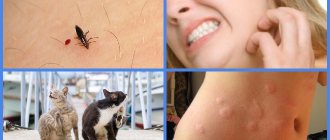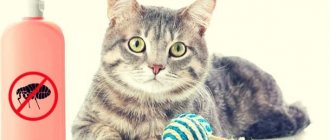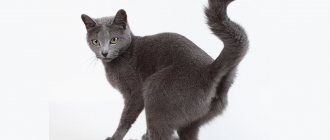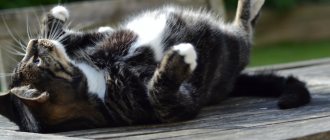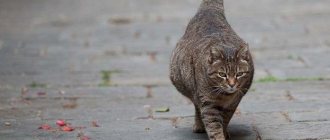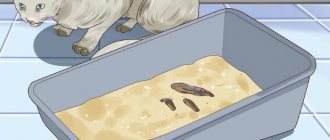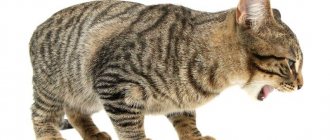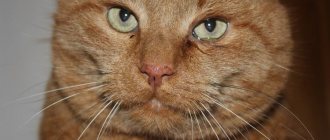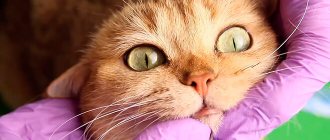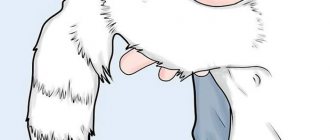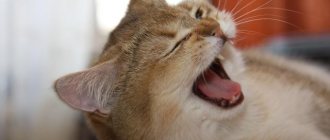Fleas are blood-sucking parasites that are quite common even in domestic cats. Infection with these insects causes anxiety, irritability, and unbearable itching in the animal, which causes scratching to appear on the body. If the owner does not take measures to remove them, the cat may develop serious diseases. In addition, although these parasites do not usually live on humans, their presence in the house can cause a lot of trouble for household members. Some human diseases are transmitted through these blood-sucking creatures.
What do fleas look like?
Fleas belong to a large order of insects, which include different subspecies. They feed on the blood of various animals and are parasites. Using a photo of fleas on a cat, you can determine the type of flea and understand that the animal is attacked by these insects.
The cat flea is one of the most common species; its body length reaches up to three millimeters. The flea has a body that is flattened on the sides, and their hind legs are very long.
- It is thanks to their long legs that they are so easily carried along the fur; female fleas are larger than males, since they lay eggs and carry them in their abdomen.
- The flea has a sucking and piercing mouth, with which it pierces the cat's skin and drinks its blood.
- There are many bristles on the surface of the flea's body, which also allows the parasite to cling tightly to the fur.
- The color of the flea can be light brown and reach black.
Morphology
The adult, like all fleas, is a small, wingless, blood-sucking insect. Body length ranges from 0.5 to 5 mm. When sucking blood, females can reach 16 mm. Body color is dark. They have cephalic and dental ctenidia. The head has 7 or 8 teeth of varying lengths located along the lower edge of the head, the thoracic has 14 or 16 teeth. The eyes are big. The anterior part of the antennal fossa is covered by the edge of the buccal lobe. The latter has a false tooth at the end. Both sexes have one developed prepygidial seta. The forehead is flat. Metepisternum has no more than two setae. The stigmas of the abdominal tergites are relatively small.
Sexual dimorphism. Individuals of different sexes differ in the structure of their genital organs.
Male. The handle of the sex claw is only slightly widened at the end.
Female. The forehead is flatter.
The egg is about 0.5 mm long, white.
Worm-shaped larva. The body is covered with long hairs and consists of three thoracic and ten abdominal segments (13 in total). It is eyeless, has short antennae and a chewing mouthparts. The maximum size of the third instar larvae is at least 5 mm.
How do fleas get started?
There are many ways your pet can become infected with parasites.
- Walk outside (fleas can be on the grass, ground and asphalt).
- Human contact (fleas can be brought home on clothing or shoes).
- Transmission from the mother (if a pregnant cat has fleas, there is a high chance that the parasites will be transmitted to newborn kittens).
- Contact with rodents.
Fleas: The Danger of Parasites
It is important to know that fleas on a domestic cat can be very dangerous for your pet.
- Fleas carry various diseases and even worm eggs.
- Because of the bites, wounds appear on the cat's skin, the fur becomes dull and begins to fall out.
- If the number of fleas constantly increases, this leads to feline anemia and negatively affects the health of the animal.
- Development of allergies.
Fleas particularly affect cats in poor health, as well as newborn kittens and older cats. In addition, the presence of fleas can be potentially dangerous for humans; if a flea gets into food, poisoning is possible. The parasite can bite through human skin, which will lead to dermatitis and various skin diseases.
Appearance of the larvae
Flea larvae
What flea larvae look like depends on the stage of development. Initially they are born as white, translucent worms. Length does not exceed 1 mm. Their food consists of feces of adults, skin remains, and rot. They begin to eat actively.
Over time, worms accumulate in places where they can find food:
- dog bedding, cat mats;
- trash bins;
- baskets for storing vegetables, flower pots;
- pet toilet, feeders.
A week later, the first molt occurs. Flea larvae increase in size, but do not change appearance. The worms are already more like a caterpillar. The contents of the esophagus are visible through the transparent body. The color becomes dirty gray. During the entire developmental stage, the flea molts three times. Increases to 4 mm.
At the last stage of flea development, pupation occurs. The larva envelops itself in a cocoon and stops moving. Already after 2 days it emerges from there as an adult.
Symptoms of infection
Flea infestation has three main stages, each of which is accompanied by certain symptoms.
- Initial stage - at this stage, parasites can be detected if you carefully examine the cat's fur and skin.
- At the second stage, the pet’s health becomes worse, the cat becomes nervous and constantly chews something out of the fur, eats and sleeps poorly.
- The third stage is accompanied by severe hair loss, weight loss and anemia. Ulcers and redness are clearly visible on the cat’s skin.
It is important to notice the appearance of fleas in a cat in the early stages and begin treatment immediately.
Knowing how to remove fleas from a cat, you can help your pet recover and start living a full life without constant scratching and pain.
Removing fleas at home
If fleas are found on your pet, it is necessary to carry out a thorough general cleaning of the premises so that the parasites do not spread throughout the house.
Most often, flea eggs and the parasites themselves can be found on carpets and upholstered furniture, which should be vacuumed and treated with special products.
To remove fleas at home, you can use the following remedies.
- Special shampoo;
- Flea drops for cats;
- Spray;
- Medical collar;
- Pills;
The best option is to use several remedies that will give a positive effect. Many drugs can be dangerous for a cat, so it is advisable to consult a veterinarian or not use too aggressive drugs.
Disinsection of a lactating cat
If you do not expel the insects from the cat, they will again pass on to the children. Of course, finding fleas on a kitten means that there are fleas on the mother as well. You cannot wet the cat with conventional means - Stomazan or its analogues; the active components will be excreted in the milk or licked by the baby from the mother. In this regard, Stronghold drops are relatively safe; the active ingredient, Selamectin, is not excreted in milk. The drug is sold packaged in pipettes, the contents of which are applied between the shoulder blades.
The cat carries kittens, grabbing the withers
The insecticide is allowed to dry. This takes two hours. After this, the poison becomes insoluble in the kitten’s saliva. The trouble is that all the drops do not act simultaneously. It takes a day for the fleas to leave the cat or die. The insects still have a chance to jump onto the baby. Therefore, it is necessary to observe the kitten for a day or two, and if insects are found again, comb them out.
Drops Strongold
The kittens themselves can be treated with this product after weaning and reaching six weeks of age.
Flea prevention
The easiest way is not to treat your pet, but to prevent the appearance of parasites. It is important to keep your home clean and practice hygiene regularly. It is important to change and wash outer clothing, wash shoes, and keep the floor clean.
If your pet goes outside, it needs to be bathed and its paws washed. If your cat is often outdoors, use a flea-repellent collar.
They contain a special flea remedy for cats, which repels parasites and prevents them from settling in the animal’s fur. It is important to change such a collar on time, taking into account their expiration date.
The positive properties of the collar include the following qualities:
- Easy to use.
- Suitable for animals that do not like water treatments.
- Protection not only from fleas, but also from ticks.
- Can be used by pregnant cats and small kittens.
Peculiarities
These insects do not have wings, but thanks to their strong hind legs, they can jump long distances. The body of the parasite is flattened on the sides and slightly elongated in height. This structure of the body gives it the ability to move in the fur with lightning speed.
The dense cover and flattened appearance protect insects well - even if you catch a flea, you cannot kill it with your fingers alone; you must crush the parasite with your fingernail. This invulnerability allows fleas to bite as painfully as possible.
It differs from other relatives - rat and dog fleas, as well as those that parasitize cats, in its smaller size. Also, her backside is not raised, like a rat's. It is worth noting that such nuances are almost impossible to see with the naked eye.
Traditional methods for fleas
If for some reason you do not want to use store-bought flea products, you can turn to traditional medicine and rid your pet of parasites.
- It is necessary to prepare an infusion of celandine and salt, in which the cat must be thoroughly bathed and allowed to stand in this water. For 50 grams of celandine, take 1 liter of water.
- Two or three cloves of garlic need to be turned into a liquid pulp and mixed with 700 ml of water. This infusion must be rubbed into the cat's fur at night, and the pet must be combed in the morning.
- A strong infusion is made from dry and fresh wormwood. The product is applied to the cat's fur, then the animal must be bathed with shampoo and combed well.
Insecticides: Rules for use
Flea allergies in cats can have dire consequences, so it is best to use proven insecticides that will give positive results.
- Under no circumstances should the insecticide come into contact with the cat’s mucous membranes;
- The cat should not reach with its tongue the place where its fur was treated with drops;
- Spray treatment should be carried out carefully; the spray should not come into contact with the cat’s eyes, nose and mouth;
- After treating your pet, you need to ventilate the room;
If the product gets on the mucous membrane, you need to rinse it with plenty of clean water.
